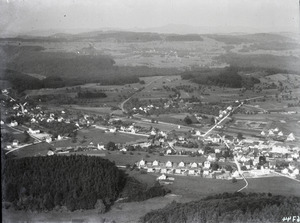Illnau-Effretikon facts for kids
{{Infobox Swiss town | subject_name = Illnau-Effretikon | municipality_type = municipality | image_photo = Kirche Illnau 2012.jpg | imagepath_flag = ![]()
![]() | imagepath_coa =
| imagepath_coa = ![]()
| pixel_coa = | canton = Zurich | iso-code-region = CH-ZH | district = Pfäffikon |coordinates = 47°26′N 8°42′E / 47.433°N 8.700°E | postal_code = 8307 Effretikon
8308 Illnau | municipality_code = 0296 | area = 25.28 | elevation = 516|elevation_description= | population = 16298 | populationof = December 2020 | popofyear = 2020 | website = www.ilef.ch | mayor = Ueli Müller|mayor_asof=March 2014|mayor_party= | mayor_title = Stadtpräsident|list_of_mayors = | parliament_name = Grosser Gemeinderat | parliament_number_of_members = 36 | executive_name = Stadtrat | executive_number_of_members = 9 | places = Illnau, Effretikon, Ottikon bei Kemptthal, Bisikon, Agasul, Bietenholz, Billikon, First, Horben, Kemleten, Luckhausen, Mesikon, Oberkempttal | demonym = | neighboring_municipalities= Fehraltorf, Kyburg, Lindau, Russikon, Volketswil, Weisslingen, Winterthur | twintowns = Orlová (Czech Republic), Grossbottwar (Germany), Calanca, Mont-sur-Rolle |} Illnau-Effretikon is a town in the canton of Zürich in Switzerland. It is part of the Pfäffikon district. This town includes the villages of Illnau, Effretikon, Ottikon, and Bisikon. In 2016, the nearby town of Kyburg joined with Illnau-Effretikon to form the larger municipality we know today.
Contents
History of Illnau-Effretikon
Illnau-Effretikon was first mentioned in old records way back in the year 745. Back then, it was known by slightly different names: Illenavvia and Erpfratinchova. For a long time, the town was just called Illnau. This was because Illnau was the main center for politics and business in the area.
Things changed when a railway line was built in 1855. This new train line connected Zurich to Winterthur. However, the train station was built in Effretikon, which was a much smaller village at the time. Because of the railway, Effretikon started to grow very quickly. It became much bigger and more important than Illnau.
By the early 1900s, Effretikon had grown so much that it was larger than Illnau. So, in 1973, the name of the town was officially changed to Illnau-Effretikon. This new name showed that both parts were important. Later, on January 1, 2016, the town of Kyburg also joined with Illnau-Effretikon.
Geography of Illnau-Effretikon
Illnau-Effretikon covers an area of about 25.3 square kilometers (about 9.8 square miles). A large part of this land, about 52%, is used for farming. Forests cover nearly 30% of the area. About 17% of the land is developed with buildings and roads. The rest is made up of natural features like rivers.
The town is located in a valley called the mid-Kempt valley. It includes several villages. These are Illnau, Effretikon (which also includes Rikon), Ottikon, and Bisikon. There are also smaller communities called hamlets. Some of these hamlets are Agasul, Bietenholz, First, Horben, Kemleten, Luckhausen, and parts of Billikon, Mesikon, and Oberkempttal.
People and Life in Illnau-Effretikon
Illnau-Effretikon has a population of over 17,000 people. About 20% of the people living here are from other countries. Most people in Illnau-Effretikon speak German, which is the main language. Italian is the second most common language, followed by Albanian.
When it comes to politics, the most popular political group in the 2007 election was the SVP. Other popular groups included the SPS and the FDP.
The population of Illnau-Effretikon includes many young people. About 20% of the population are children and teenagers (under 20 years old). Most adults (ages 20-64) make up about 67% of the population. People over 64 years old make up about 13%. Most adults in Illnau-Effretikon have completed high school or gone on to higher education like university.
The town has a low unemployment rate, which means most people who want to work can find jobs. Many people work in different types of jobs:
- Primary sector: This includes jobs like farming.
- Secondary sector: This includes jobs in manufacturing and construction.
- Tertiary sector: This includes jobs in services, like shops, offices, and healthcare.
In terms of religion, many people in Illnau-Effretikon are Christian. About 48% are Protestant, and about 28% are Catholic. There are also people who follow other religions, such as Islam, or who do not follow any religion.
The population of Illnau-Effretikon has grown a lot over time:
| year | population |
|---|---|
| 1634 | 878 |
| 1799 | 2,525 |
| 1850 | 2,845 |
| 1900 | 2,767 |
| 1950 | 4,357 |
| 1970 | 13,693 |
| 1990 | 14,566 |
| 2000 | 14,491 |
Transportation in Illnau-Effretikon
Illnau-Effretikon has two important train stations that help people travel around. The Effretikon railway station is on the main train line that goes from Zurich to Winterthur. Many different local train lines, called S-Bahn routes (like S2, S3, S7, S8, S19, and S24), stop here.
The other station is Illnau railway station. This station is on a different line that goes from Effretikon to Hinwil. The S3 and S19 S-Bahn lines also stop at Illnau. These train connections make it easy for people to commute and visit other towns.
Notable People from Illnau-Effretikon
- Ludwig Zehnder (1854–1949): He was a Swiss physicist born in Illnau. He invented a special tool called an interferometer, which is used to measure light waves.
- Walter Roderer (1920–2012): He was a Swiss actor and screenwriter who lived in Illnau.
- Fabian Molina (born 1990): He is a Swiss politician who grew up in Illnau-Effretikon. He is a member of the National Council, which is part of the Swiss government.
See also
 In Spanish: Illnau-Effretikon para niños
In Spanish: Illnau-Effretikon para niños



